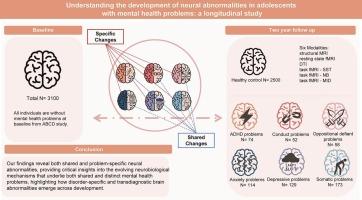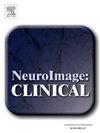了解有心理健康问题的青少年神经异常的发展:一项纵向研究
IF 3.6
2区 医学
Q2 NEUROIMAGING
引用次数: 0
摘要
许多心理健康问题本质上是神经发育问题,并且在儿童时期发病。这些疾病与神经异常有关,但尚不清楚这些疾病何时出现,以及这与不同心理健康问题的发展有何关系。方法:我们从青少年大脑认知发展(ABCD)研究中确定了两年内出现心理健康问题的儿童和保持健康的对照组。六种精神健康状况(N = 58至N = 173)与对照(N = 2500)使用单独的线性模型进行比较,以评估六种疾病和六种模式的基线和神经发育组差异。通过比较基线和随时间的不同条件下大脑变化的空间模式来评估共同的神经发育变化。结果基线数据显示,后来出现心理健康问题的儿童的全脑异常,内化问题与外化问题之间具有可比性,而与外化问题之间存在差异。脑区域特异性异常仅限于后来出现对立违抗症状的个体。纵向数据显示,在患有多动症、行为和焦虑问题的青少年中,特定大脑区域的神经发育轨迹存在差异,而在精神健康问题组与对照组之间,全脑神经发育异常也具有可比性。我们的研究结果揭示了共同的和问题特异性的神经异常,为揭示共同的和不同的精神健康问题背后不断发展的神经生物学机制提供了重要的见解,突出了疾病特异性和跨诊断性脑异常是如何在整个发育过程中出现的。本文章由计算机程序翻译,如有差异,请以英文原文为准。

Understanding the development of neural abnormalities in adolescents with mental health problems: A longitudinal study
Background
Many mental health problems are neurodevelopmental in nature and have an onset during childhood. These disorders are associated with neural abnormalities, but it is unclear when these emerge and how this relates to the development of different mental health problems.
Methods
We identified children who developed mental health problems over two years and controls who remained healthy from the Adolescent Brain Cognitive Development (ABCD) study. Six mental health conditions (N = 58 to N = 173) were compared to controls (N = 2500) using separate linear models to assess group differences at baseline and in neurodevelopment for six disorders and six modalities. Shared neurodevelopmental changes were assessed by comparing spatial patterns of brain alterations across conditions at baseline and over time.
Results
The baseline data showed brain-wide abnormalities in children who later developed mental health problems, which were comparable between internalizing problems and different from externalizing problems. Brain-region specific abnormalities were limited to individuals who later developed oppositional defiant symptoms. The longitudinal data showed differential neurodevelopmental trajectories for specific brain regions in adolescents who developed ADHD, conduct and anxiety problems, as well as brain-wide neurodevelopmental abnormalities that were comparable between mental health problem groups compared to controls.
Conclusions
Our findings reveal both shared and problem-specific neural abnormalities, providing critical insights into the evolving neurobiological mechanisms that underlie both shared and distinct mental health problems, highlighting how disorder-specific and transdiagnostic brain abnormalities emerge across development.
求助全文
通过发布文献求助,成功后即可免费获取论文全文。
去求助
来源期刊

Neuroimage-Clinical
NEUROIMAGING-
CiteScore
7.50
自引率
4.80%
发文量
368
审稿时长
52 days
期刊介绍:
NeuroImage: Clinical, a journal of diseases, disorders and syndromes involving the Nervous System, provides a vehicle for communicating important advances in the study of abnormal structure-function relationships of the human nervous system based on imaging.
The focus of NeuroImage: Clinical is on defining changes to the brain associated with primary neurologic and psychiatric diseases and disorders of the nervous system as well as behavioral syndromes and developmental conditions. The main criterion for judging papers is the extent of scientific advancement in the understanding of the pathophysiologic mechanisms of diseases and disorders, in identification of functional models that link clinical signs and symptoms with brain function and in the creation of image based tools applicable to a broad range of clinical needs including diagnosis, monitoring and tracking of illness, predicting therapeutic response and development of new treatments. Papers dealing with structure and function in animal models will also be considered if they reveal mechanisms that can be readily translated to human conditions.
 求助内容:
求助内容: 应助结果提醒方式:
应助结果提醒方式:


